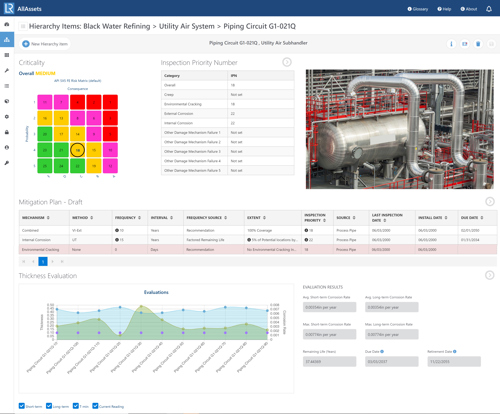2020 AFPM Summit: Sweating oil and gas asset data in a challenging environment
Sweating oil and gas asset data in a challenging environment
NEIL ARTHUR, Lloyd’s Register
With the current macro-economic environment driving rapid changes in both supply and demand, E&P companies are increasingly seeking surety of insight into their operations. At the same time, industry is recognizing the value of digital technologies to mitigate operational risk, optimize asset performance and enable a confident response to today’s production challenges by providing access to data.
A digital infrastructure that can adapt to an evolving environment is an essential tool to help businesses stay agile. Utilization of digital technology and harnessing the data it generates drive down production costs and push up productivity; however, extraction of insight from data is difficult, and trusting the data for critical operations can be a challenge. Many organizations are drowning in data, but most that data is never used, and so the benefits of digital technologies are not realized. Taking the right steps now can ready businesses taking a longer-term view to pursue new opportunities.
The perennial thorn. Unplanned downtime, or worse, a containment incident, for example, that harms people and/or the environment can set back production gains in an instant. Safe and reliable operations are moral and business imperatives. Yet, while asset management and maintenance teams continue to see thousands of work orders generated by their enterprise asset management (EAM) or computerized maintenance management systems (CMMSs), there is often little detail as to the origin of the order or whether it can be changed. As such, many teams lack the ability to truly understand and prioritize asset risk and the consequence of failure.
Furthermore, an aging workforce means many organizations are suffering the loss of their risk and reliability subject matter expertise—these people are crucial to performing accurate risk-based analysis of plant assets to investigate why an asset failed, so they can prevent such failures in the future. Over time, this has created a burden beyond many workforces’ ability to manage and address.
While technology to alleviate these challenges has progressed and been made easier to deploy and connect to systems, adoption and implementation is often a struggle. The result: an inability to fully address the causes of unplanned downtime, an overwhelming number of work orders and an inefficient deployment of maintenance resources, putting operations at risk. Now more than ever, businesses will benefit from hurdling these challenges and gaining the insight needed to streamline asset maintenance in increasingly adverse conditions. So, what is stopping them?
Troubleshooting the data roadblock. Continually optimizing the content of the EAM/CMMS system in operation is vital to maximize ROI, but that practice of optimization has not always been the case.
If you were an early adopter of EAM, your system setup may no longer be relevant or helpful to ensure safe operations, minimize risk and manage OPEX efficiently. The data structure from a previous implementation may not be conducive to maintaining and servicing the highly complex and aging infrastructure of today. In some cases, previous EAM/CMMS implementations relied on future tools and capability that are still in development.
In these instances, terabytes of data are being collected throughout an asset’s lifecycle but are not being harnessed by the immense power of advanced analytics and digital risk modelling to further business objectives. This raises the question, what is the value of collecting it in the first place?
At the other end of the scale, some organizations lack accessible data on assets and equipment entirely. The lack of robust reliability and analytical tools means that they are unable to focus personnel efforts to where the largest cost savings and benefits are.
In the current climate of belt-tightening, there is a worry that properly restructuring the data to reap the full benefits of maintenance optimization will be time-consuming, costly and beyond the workforce’s capacity and capability. The consequence of this is that organizations will increasingly spend too much time and even more limited resources on routine maintenance, while more critical asset performance, safety and compliance issues are under-addressed.
Applying advanced analytics. For those organizations that have large existing investments in maintenance software, applying advanced analytics could be one way to take full advantage of the insights and efficiencies the data captured.
Advanced analytics, in the form of an asset performance management (APM) platform, enables automated interrogation of historic maintenance and inspection information, offering greater insight into an asset’s safety, risk and performance. Using an EAM system’s swathes of data intelligently, in conjunction with a modern APM solution, such as LR AllAssets, allows decision-makers to continually tune their maintenance and inspection activities in response to the changing reliability and commercial attributes of the asset or facility (FIG. 1).

FIG. 1. Advanced analytics, in the form of an asset performance management (APM) platform like LR AllAssets, enables automated interrogation of historic maintenance and inspection information.
Indeed, harnessing the power of an EAM’s intellectual property is a challenge without an APM solution. Not only can APM derive forward-looking equipment reliability data and asset performance insights, it can also help organizations keep pace with industry benchmarks and best practice.
Combining engineering expertise with new technologies, a modern APM platform offers a means to leverage the abundance of data available—rationalizing and focusing maintenance efforts based on ever-changing economic characteristics—in terms of production, product value or equipment configuration, for example, to help drive lowest total cost of ownership. Regardless of maintenance methodology, APM turns inputted data into straightforward, actionable insights that not only increase reliability and reduce risk, but can also save money and increase uptime, particularly for operators in asset-intensive industries such as oil and gas.
For optimum results, the APM platform must seamlessly integrate with the existing EAM/CMMS systems, as well as provide best-in-class equipment models/strategies from an independent industry expert. This enables an efficient and effective means of deriving an appropriate maintenance and inspection program to be deployed into an EAM, along with an associated underpinning audit trail and justification.
Leveraging APM to enable the intelligent application of data, collected by an EAM/CMMS, allows owners-operators to tune their maintenance and inspection activities in response to ever-changing environmental and business pressures. Whether the concerns are safety, reliability, the commercial attributes of your asset or facility, minimizing OPEX or reducing facility downtime, investing time now to harness data and optimize enterprise asset management systems will only pay dividends when it comes to business performance.
For more information, visit https://www.lr.org/
ABOUT THE AUTHOR

DR. NEIL ARTHUR is the Technical Director APM, Digital Products, for Lloyd’s Register.






Comments